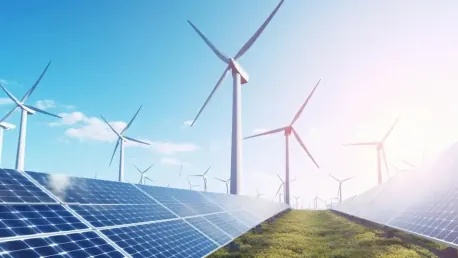China has achieved significant milestones in its renewable energy sector, particularly in harnessing solar and wind power. Data from the Chinese National Energy Administration reveals that as of July 2024, the country’s total installed power generation capacity climbed to 3.1 billion kilowatts. Solar power accounts for roughly 740 million kilowatts, while wind power contributes approximately 470 million kilowatts. This development is notably ahead of China’s commitments, made six and a half years ago, to reach a combined installed capacity of 1.2 billion kilowatts from wind and solar sources by 2030. These achievements indicate China’s proactive and ambitious approach in transitioning to renewable energy, a move that is consistent with global efforts to mitigate climate change.
The rapid growth of photovoltaic (PV) power has been a focal point in China’s renewable energy narrative. Between 2020 and 2022, PV power experienced a significant boom, followed by steady growth in subsequent years. The combined capacity of wind and solar increased from 280 million kilowatts at the end of 2020 to 470 million kilowatts by July 2024. A noteworthy impact of these developments has been the transformation of China’s energy mix. The combined capacity of wind and solar power has risen from 24% in 2020 to about 39% currently. This transition not only diversifies the country’s energy sources but also demonstrates China’s commitment to reducing its reliance on fossil fuels, thereby curbing greenhouse gas emissions.
Challenges and Solutions in Grid Management
Despite these advancements, the intermittent nature of wind and solar energy poses significant challenges to consistently meeting peak electricity demands. Many new energy facilities are located in remote areas, far from major urban centers where demand is highest. Predominantly situated in the northwest, northeast, and southwest regions, this geographic mismatch exacerbates the discrepancies in supply and demand across various regions and times. Addressing this supply-demand imbalance requires innovative solutions and robust grid management to ensure the reliable delivery of electricity generated from renewable sources.
To overcome these obstacles, Chinese authorities have initiated several measures aimed at enhancing the energy system’s resilience. In May 2024, the National Energy Administration (NEA) issued a notice outlining new grid-supporting projects designed to improve system regulation and grid-connection performance. These initiatives focus on bolstering grid resource allocation capabilities and leveraging market mechanisms more effectively. Moreover, the NEA and the National Development and Reform Commission released an action plan in July 2024, aimed at constructing a new type of power system from 2024 to 2027. This plan encompasses nine special actions to stabilize the system and develop an intelligent dispatch system, showing a proactive stance in addressing the challenges posed by renewable energy integration.
Future Prospects and Strategic Policies
China has reached significant milestones in its renewable energy sector, especially in solar and wind power. According to the Chinese National Energy Administration, by July 2024, the nation’s total installed power generation capacity hit 3.1 billion kilowatts. Solar power makes up around 740 million kilowatts, while wind power adds roughly 470 million kilowatts. This progress surpasses China’s earlier commitment made six and a half years ago, pledging to attain a combined installed capacity of 1.2 billion kilowatts from wind and solar by 2030. These achievements highlight China’s proactive stance in adopting renewable energy, aligning with global goals to tackle climate change.
The rapid rise of photovoltaic (PV) power has been central to China’s renewable energy journey. From 2020 to 2022, PV power saw an impressive surge, followed by steady growth. The combined wind and solar capacity jumped from 280 million kilowatts at the end of 2020 to 470 million kilowatts by July 2024. These advancements have significantly changed China’s energy mix, with wind and solar’s share rising from 24% in 2020 to about 39% currently. This shift not only diversifies China’s energy sources but also shows its dedication to cutting down on fossil fuels, thereby reducing greenhouse gas emissions.









